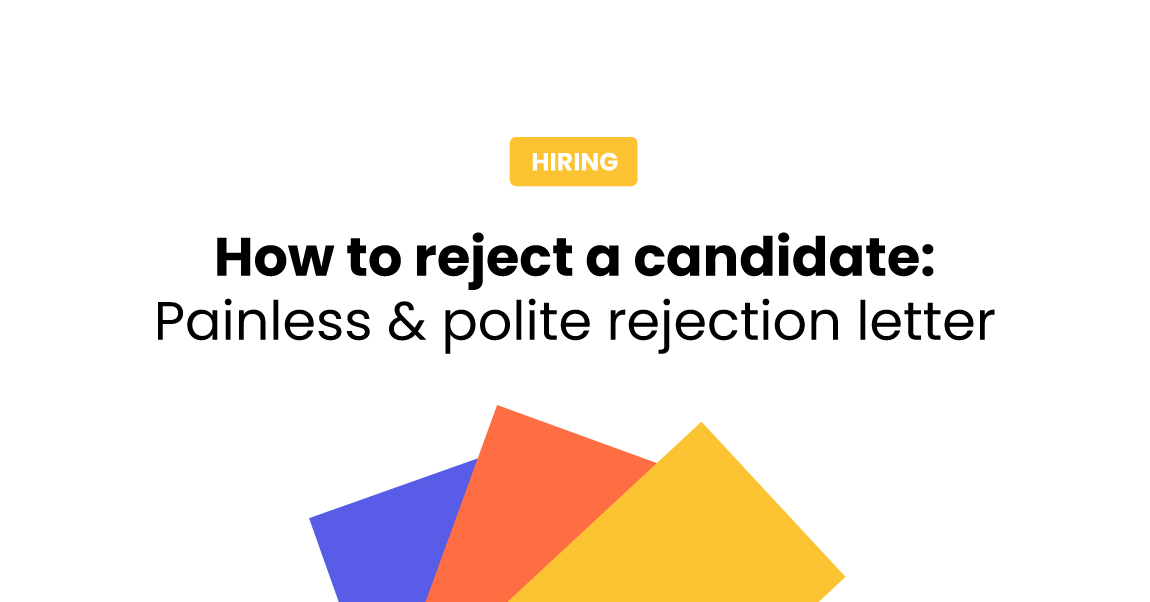An official recruiters’ mantra: shooting the messenger is just a phrase. Still, every single recruiter and hiring manager absolutely hates to be the one who breaks the news to rejected job seekers. But on the bright side – everyone can learn how to reject a candidate (without ghosting, stalling, and ultimately causing a massive backlash).
Here’s a disclaimer: the feeling while sending a rejection letter will never be amazeballs. But honest, clear, and informative letters might just help candidates do way better the next time around. And they can certainly build up the company’s reputation & help recruiters stay in touch with former prospects. So, get ready for the most simple guide that actually works!
Common reasons to reject a candidate after the interview
We all hate breaking the bad news. But sometimes, that’s just inevitable. And in a recruiter’s world, rejection occurs more than anyone would like. And yes – it goes both ways. So, what are the 3 most common reasons for rejecting candidates?
🚩 Overall poor communication, including verbal, non-verbal, and listening skills,
🚩 The lack of accessibility, responsiveness, and timeliness,
🚩 A massive gap between the candidate’s goals and plans and the company’s aims + the disagreement between candidates’ skills and background and the actual job description.
There are other red flags to keep an eye on and reasons to send out a rejection letter. Recruiters usually get suspicious when they spot a resume that suggests job hopping. And they’re often right. The key is to ask the right questions and see whether the candidates can answer them precisely. Vague, formless responses and inconsistencies regarding one’s career path are bound to sound an alarm and urge a recruiter to keep looking for a more suitable hire.
Also, recruitment specialists sometimes spot an absence of passion and (proper) motivation. And when they do, they commonly dismiss a person that showcased similar characteristics and behaviors.
How do recruiters reject candidates? [The good, the bad, and the ugly]
According to a new 2022 survey, an average job seeker gets rejected between 6 and 10 times before landing a career opportunity they sought. And here’s what everyone needs to grasp: a rejection email is more than professional courtesy. Sure, it’s no picnic sending it, but it does drive certain advantages. For once, it delivers the essential info quickly and provides a sort of emotional closure to those who have applied (or were recruited) but weren’t very successful during the process. And also, a well-crafted, truthful, and respectful rejection letter might turn candidates into brand ambassadors, even when the final outcome wasn’t ideal.
So, to do it right, it’s essential to learn how to dodge a few common mistakes and embrace some of the best practices.
5 common mistakes recruiters make when rejecting candidates
Studies show that more than 50% of Americans believe in ghosts. And according to every hiring process ever, 100% of recruiters believe in ghosting 👻. Wanna know the crazy part? Ghosting works both ways. So, here’s a number one no-good practice to avoid at all costs: never leave an applicant or interviewee hanging. Be sure to notify them promptly, regardless of the results they’ve achieved.
Now, here are a few more dishonorable mentions & familiar rejection emails no-nos:
❌ Don’t fail to personalize the letter
Using generic greetings, non-specific phrases, and lacking actual feedback is a bad & ugly practice that each recruiter needs to steer clear of.
❌ Don’t shut the door behind you
Leave room for future opportunities because those who aren’t the best fit at the moment might become new hires when a slightly different position opens.
❌ Don’t be afraid to use tools
Automation and personalization don’t feel compatible at first. However, some tools and gizmos are made to improve the recruitment process. So, for instance, pick a suitable applicant tracking system to be extra sure about your progress, candidates’ statuses, and the emails that were scheduled or sent.
❌ Don’t waste time
The decision-making process isn’t always fast & smooth. If the hiring managers and interviewers can’t get on the same page, it is still a recruiter’s duty to keep the candidate posted and engaged.
❌ Don’t lose track on communication
In the delicate process of rejecting candidates, maintaining clear and transparent communication is important. To uphold professionalism and ensure compliance with regulations, businesses should save and archive all email communications with candidates. Highlighting the significance of archiving software, preferably cloud-based, can streamline this process.
Finally, it is essential to think about the candidate experience at all times. Recruiters have to consider the aftermath of the rejection letters they’re sending. In other words – can we legit hope that the email found someone well?

How to reject a candidate via email
The first rule to recruiting (and, sadly – rejecting) candidates is to be clear and transparent. So, when drafting these emails, be sure to state an objective reason for turning down a job seeker. Now, this particular point requires the perfect blend: being precise and realistic while minding the wording and tone. It is essential to maintain the human touch + straightforward attitude. In other words, plain templates and automated messages are out of the question. While you’re at it, follow these guidelines.
✨ Keep the good vibes going and manifest positivity.
Yes, they’ve been looking to receive a note that says, “you’re hired.” And this bad news will come as a shock. So, write an extra line or two and speak to their traits, skills, and qualifications. Add a dash of true praise and optimism. The language you use should also encourage them to apply next time.
📝 Just be brief.
It sounds easy, but once you start mixing a friendly approach with “sandwich feedback,” it can become a bit tough to keep it short and sweet. So here’s the formula: just ensure to mention the company’s decision not to hire a specific candidate right away. Avoid confusion and go for a one-page rejection letter.
📢 Respond to literally everyone.
Some rejected candidates reach the final stages of the candidate journey. Others, on the other hand, fail to make it past the application and cover letter. Even if the job ad was aimed at seasoned professionals (whether it’s senior software developers you are looking for or highly skilled designers, marketers, or someone else), some beginners will give it a shot and hit the apply button. Don’t answer with a lazy sample. Offer a heartfelt text instead.
💡 One final tip
Money-related issues and miscommunication are often the reason not to make collaboration work. Salary transparency in job ads can help you communicate more effectively with the candidates later in the process. That way, you’ll encounter fewer job seekers whose expectations aren’t aligned with your budget and avoid sending/getting rejection notes.
Use this guide on how to reject a candidate politely & keep the door open.
So, just to make sure we’ve all grasped the simple truth: no one actually shoots the bearer of bad news. Sure, some generic rejection letters induce eye-rolls, angry Glassdoor reviews, and Reddit + Twitter rants. But there are no real guns (just puns) in relation to recruiters.
Still, it’s vital to have common mistakes, and sluggish moves sidestepped when notifying a candidate about their status. Use this brief guide to let rejected candidates down slowly and politely, and help them learn about their best skills & the ones they need to have improved. Build strong bonds and stay open for future collaborations.
Need a reliable tech recruitment agency that will help you communicate with candidates smoothly & build up your relationships with talents? We got you.




